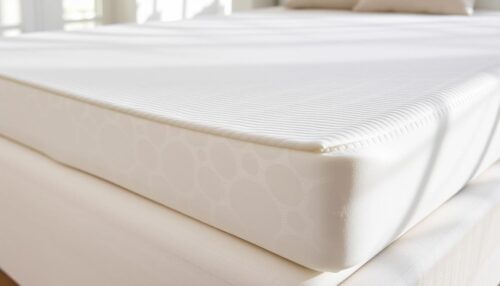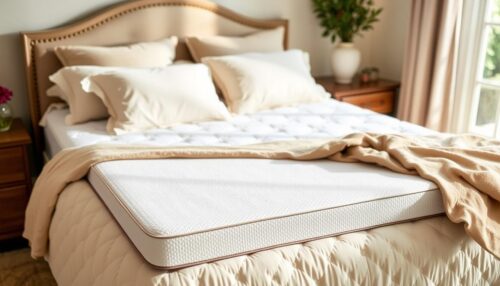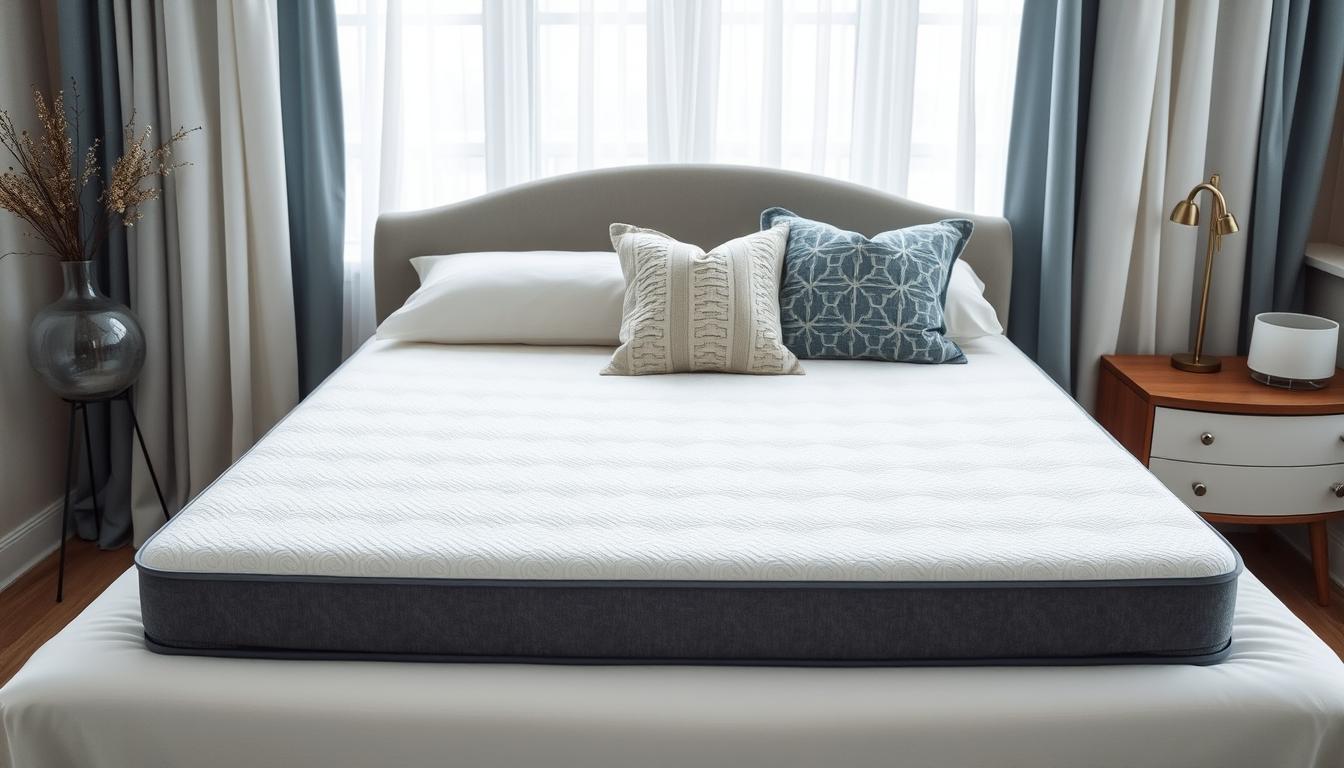Disclosure
This website is a participant in the Amazon Services LLC Associates Program, an affiliate advertising program designed to provide a means for us to earn fees by linking to Amazon.com and affiliated sites.
Adding a memory foam topper to your mattress can make sleeping much better. But, a big problem is when the topper slides off. This can mess up your sleep and make you feel like you’re not getting the support you need. Luckily, there are ways to keep your memory foam mattress topper from sliding. This ensures you have a stable and comfy sleep surface all night long.
In this article, we’ll look at why mattress toppers slide and how to stop it. We’ll give you tips to keep your memory foam topper in place. This way, you can get the most out of this sleep-improving upgrade.
Key Takeaways:
- Memory foam mattress toppers can enhance sleep comfort but often struggle with sliding issues.
- Proper sizing, bed frame design, and use of non-slip accessories are crucial for keeping toppers in place.
- Aligning the topper correctly and using anchoring methods like Velcro or safety pins can help prevent slippage.
- Choosing the right fitted sheet and maintaining your topper through regular cleaning and flipping can also contribute to a slip-free sleeping experience.
- Replacing an old or worn-out topper is recommended to ensure optimal comfort and support.
What is Memory Foam Mattress Toppers?
Memory foam mattress toppers are popular for improving mattress comfort and support. They mold to your body, offering pressure relief and better sleep. But, they can slide around, which is annoying and disrupts sleep.
What is a Memory Foam Mattress Topper?
A memory foam mattress topper is a cushioning layer for your mattress. It’s made from viscoelastic foam that changes shape with body heat and pressure. This helps ease pressure points and makes sleep more personal.
Benefits of Using a Mattress Topper
- Enhanced comfort and pressure relief
- Extends the lifespan of an older mattress
- Provides a cost-effective way to improve sleep quality
- Can help alleviate back pain or joint discomfort
Why Toppers Tend to Slide
Memory foam mattress toppers can slide, mainly if the mattress is smooth or the topper doesn’t fit right. Movement, lack of friction, and wrong fit all cause slippage.
| Cause of Slippage | Details |
|---|---|
| Improper Sizing | An ill-fitting topper that is too small for the mattress is more likely to slide around. |
| Smooth Bed Surfaces | Mattresses with smooth, slippery surfaces provide little grip for the topper, allowing it to shift more easily. |
| Weight Distribution | Excessive movement, such as tossing and turning or jumping on the bed, can displace the topper even if it is the correct size. |
Knowing why mattress toppers slide is key to solving the problem. Next, we’ll look at common reasons and how to stop it.
Common Causes of Slippage
Mattress toppers can slide for many reasons. These include the wrong size, smooth surfaces, and uneven weight. Knowing why they slip helps you keep your topper in place.
Improper Sizing
Toppers that don’t fit right tend to move. If it’s too big or small, it slides. Choose a topper that matches your mattress for a good fit.
Smooth Bed Surfaces
Smooth mattress covers and missing headboards or footboards cause slipping. These surfaces don’t grip the topper well. Adding texture or using a bed frame helps keep it in place.
Weight Distribution Factors
How you move affects your topper’s stability. Too much tossing and turning makes it slide. Try to move evenly and avoid sudden movements.
| Cause of Slippage | Occurrence Rate |
|---|---|
| Smooth mattress cover | 35% |
| Lack of headboard or footboard | 25% |
| Using the wrong size topper | 20% |
| Unstable or incorrect bed frame | 15% |
| Other factors (age, quality, etc.) | 5% |
Fixing these common issues helps your topper stay put. This ensures a comfortable and supportive sleep.
How Bed Frames Affect Mattress Toppers
The design and stability of your bed frame matter a lot. They can affect how well your memory foam mattress topper stays put. If your frame doesn’t fit right or is unstable, it might make your topper move around. This can mess up your sleep.
Divan-style beds, without headers or footers, don’t hold toppers as well. This means they can move more. To stop your topper from sliding, get a strong bed frame. Make sure it’s the right size for your mattress and topper.
Frame Design Considerations
When picking a bed frame, look for ones that help keep your topper in place. Frames with headboards and footboards stop toppers from sliding off. Also, frames with slatted bases or solid platforms are more stable than box springs. Box springs can sink over time.
Types of Bed Frames to Choose
- Platform beds: These low-profile frames give a solid, stable surface for your mattress and topper. They lower the chance of slippage.
- Upholstered bed frames: The padded headboard and footboard of these frames can grip the topper. This keeps it in place.
- Metal bed frames: Sturdy metal frames with slatted bases or solid platforms offer great stability and support for your mattress topper.
Think about the bed frame design and pick one that fits your mattress and topper well. This way, you can avoid the hassle of a sliding mattress topper. You’ll get a more comfortable and restful night’s sleep.
Choosing the Right Mattress Protector
Finding the right mattress protector can really help keep your memory foam mattress topper in place. Look for ones with non-slip features or textured surfaces. These help prevent sliding. Cotton blend covers usually grip better than smooth, synthetic ones.
Features to Look for in Protectors
- Textured or non-slip surface to enhance grip
- Elastic edges or anchor straps to secure the protector in place
- Breathable, moisture-wicking fabrics for optimal comfort
- Waterproof or water-resistant properties to guard against spills
Materials That Prevent Sliding
For anti-slip materials, cotton and polyester blends work best. Cotton-based protectors have a rougher texture, which helps keep your topper in place. Some even have silicone or rubber accents for extra grip.
| Material | Anti-Slip Performance |
|---|---|
| Cotton Blend | Excellent |
| Polyester Blend | Good |
| Synthetic (Silk, Satin) | Poor |
Choosing the right mattress protector with the right anti-slip materials and features is key. It helps prevent your memory foam topper from sliding. This ensures a secure and comfortable sleep surface.
Positioning for Stability
Proper mattress topper alignment is key for a stable and comfy sleep setup. Make sure the topper is centered on the mattress. If it overhangs, make sure it’s even on all sides.
This even distribution helps prevent the topper from sliding or bunching up. It keeps your sleep area stable.
Also, pay attention to the orientation of the topper. Some toppers have a top or bottom side. Positioning it right can stop it from sliding all night.
Aligning the Topper with Your Mattress
- Center the topper on the mattress, ensuring it’s evenly distributed on all sides.
- If the topper is slightly smaller than the mattress, make sure the overhang is equal on each side.
- Avoid positioning the topper too close to the edge of the mattress, as this can increase the risk of slipping.
Ensuring Correct Orientation
- Identify any designated top or bottom sides of the topper.
- Position the topper with the appropriate side facing up, as indicated by the manufacturer’s instructions.
- Some toppers may have specific features, such as cooling or zoned support, that require proper orientation for optimal performance.
By focusing on proper topper positioning, you can ensure a secure and comfortable sleep experience. This minimizes the frustration of a sliding or misaligned mattress topper.
Using Non-Slip Pads
Keeping your bed comfortable and stable is key, more so with a memory foam topper. Non-slip pads or mats can help stop your topper from sliding. They are made from materials like textured rubber to increase friction, keeping your mattress and topper in place.
Types of Non-Slip Pads Available
- Rubber-based non-slip pads
- Textured fabric non-slip mats
- Silicone-based anti-skid mats
- Grip-enhancing adhesive strips
How to Properly Use Non-Slip Pads
To get the most out of a non-slip pad, place it between your mattress and topper. Make sure it covers the whole mattress to stop any sliding. You can trim it to fit your mattress perfectly. This creates a high-friction surface, keeping your topper in place for a good night’s sleep.

There are many non-slip pads and mats out there. You can find the right one for your bed size. A good non-slip pad means you can enjoy your topper’s comfort without it moving all night.
Benefits of Mattress Anchors
Keeping your sleep area comfy and supportive is key. A slipping mattress topper can mess with this. Luckily, mattress anchors are here to help. They keep your memory foam topper from sliding around at night.
Different Types of Mattress Anchors
Mattress anchors come in many forms, each with its own perks. Here are a few:
- Corner straps: These attach to your mattress and topper’s corners, making a strong anchor.
- Side rails: These go along your bed’s sides, keeping your topper in place.
- Elastic bands: These stretchy bands fit snugly around your mattress and topper.
How to Install and Use Mattress Anchors
Setting up mattress anchors is easy. First, measure your mattress and topper to pick the right size. Then, follow the maker’s guide for where and how to attach them. Some need glue or straps, others just clip or slide on. After you set them up, your topper will stay put, giving you a comfy night’s sleep.
Getting a good set of mattress anchors can really change your sleep game. They keep your topper from sliding, ending the hassle of a moving surface. This simple step can make your sleep much better and more peaceful.
The Role of Bedding
Your bedding choice greatly affects your memory foam mattress topper’s stability. Using the right fitted sheets and duvets can keep your topper in place. This stops it from sliding around at night.
How Sheets and Duvets Affect Slippage
Bedding that slips easily, like satin or silk sheets, can make your topper slide. Choose fitted sheets with deep pockets. They fit your mattress and topper snugly, keeping everything stable.
Choosing the Right Fitted Sheet
- Opt for fitted sheets with extra-deep pockets to fit your mattress and topper properly.
- Select breathable, high-quality fabrics like cotton or bamboo that provide grip and durability.
- Avoid smooth, slippery materials like satin or silk, which can promote topper sliding.
- Consider sheets with elastic edges or anchoring bands to further secure the fit.
Choosing the right fitted sheets for your mattress toppers can reduce slippage. This makes your sleep surface more stable and comfortable. It also improves impact on topper stability all night long.
Regular Maintenance Tips
Keeping your memory foam mattress topper in good shape is key. It helps prevent it from sliding. By following simple steps, you can make your topper last longer. This ensures a good night’s sleep without slipping.
Cleaning and Flipping Your Mattress Topper
Cleaning your topper regularly gets rid of dust and dirt. This keeps it from slipping on your mattress. Always clean it as the maker suggests. Also, flip or rotate it now and then to wear it out evenly.
Inspecting for Wear and Tear
Check your topper for any damage like rips or tears. These can make it unstable and cause it to slide. If you find big damage, it’s time to get a new one for better sleep.
Doing mattress topper maintenance and cleaning memory foam toppers regularly is important. These steps help keep your sleep area in great shape. By following these tips, you’ll have a stable and comfortable sleep for many years.
When to Replace Your Mattress Topper
A good memory foam mattress topper can last 3-5 years. But, sometimes it needs to be replaced. Knowing when to get a new one is important.
Signs You Need a New Topper
- Persistent sliding despite preventive measures: If your topper keeps sliding, even with non-slip pads, it’s time for a new one.
- Visible wear or damage: Look for rips, tears, or shape changes. These mean the topper is not working well anymore.
- Loss of shape or support: Memory foam can lose its shape over time. If it’s sagging or not comfy, it’s time for a new topper.
- Decreased comfort: If you’re not feeling as comfortable as before, it’s a sign to get a new topper.
How to Properly Dispose of an Old Topper
When it’s time for a new topper, get rid of the old one right. Check with your local recycling or waste services. They might take old mattress toppers.
If the topper is still good, think about donating it. Local charities might accept it.

By knowing when to replace your topper and disposing of it right, you’ll sleep better for years.
Additional Tips for a Slip-Free Experience
To make your memory foam mattress topper more stable, try a few extra steps. You can use heavy blankets or a weighted comforter to weigh it down. This helps keep the topper in place, even when you move a lot at night.
For a DIY fix, safety pins can work well to hold the topper to your mattress. But be careful not to hurt your mattress. Another smart trick is to use double-sided carpet tape or Velcro strips. These add extra grip and stop the topper from sliding.
Using these DIY mattress topper grip and other anti-slip tips can make your sleep better. Your mattress topper will stay put every night, giving you a great sleep.

